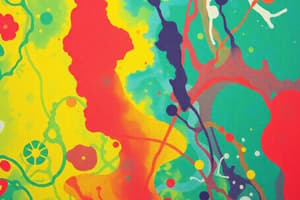Podcast
Questions and Answers
What significant changes in fashion occurred in the early 20th century?
What significant changes in fashion occurred in the early 20th century?
- Shorter hemlines and more relaxed silhouettes (correct)
- Elaborate headpieces and full-length capes
- Heavy armor-inspired garments and intricate corsets
- Bright neon colors and oversized accessories
Which fashion trend was introduced in the 1920s?
Which fashion trend was introduced in the 1920s?
- Empire waistline dresses and feather boas
- Flapper dresses and bob hairstyles (correct)
- Corseted bodices and floor-length veils
- Victorian ball gowns and updo hairstyles
What characterized fashion trends in the 1960s and 1970s?
What characterized fashion trends in the 1960s and 1970s?
- Victorian bustle skirts and lace blouses
- Regency-era empire waist dresses and silk gloves
- Edwardian high collars and ruffled sleeves
- Mini skirts, bell-bottom jeans, and tie-dye shirts (correct)
Which event led to fashion trends focusing on simplicity and practicality after World War II?
Which event led to fashion trends focusing on simplicity and practicality after World War II?
What fashion trend did Christian Dior introduce with his 'New Look' in 1947?
What fashion trend did Christian Dior introduce with his 'New Look' in 1947?
How has recent fashion evolved in response to cultural shifts and technological advancements?
How has recent fashion evolved in response to cultural shifts and technological advancements?
When did the earliest known evidence of clothing date back to?
When did the earliest known evidence of clothing date back to?
Which civilization was among the first to develop textile production on a large scale?
Which civilization was among the first to develop textile production on a large scale?
During the Middle Ages in Europe, what factor primarily dictated fashion?
During the Middle Ages in Europe, what factor primarily dictated fashion?
Which era saw an increase in the use of luxury fabrics like satin, damask, and brocade?
Which era saw an increase in the use of luxury fabrics like satin, damask, and brocade?
What event led to increased accessibility of fashion items for a wider population?
What event led to increased accessibility of fashion items for a wider population?
During the Baroque era, what characterized the fashion of both men and women?
During the Baroque era, what characterized the fashion of both men and women?
Flashcards are hidden until you start studying
Study Notes
History of Fashion
Understanding the history of fashion is crucial for anyone studying the subject. From ancient civilizations to contemporary culture, fashion has evolved significantly over thousands of years. Here's an overview of some key moments and movements in fashion history:
Ancient Civilizations
The earliest known evidence of clothing dates back to the Upper Paleolithic period, around 50,000 years ago. Clothing was made from animal skins and plant fibers. The ancient Egyptians were among the first civilizations to develop textile production on a large scale, using cotton from Africa and wool from sheep domesticated in Egypt.
Middle Ages
In Europe during the Middle Ages, fashion was largely dictated by social class. Clothing was made of linen or wool, with the wealthy wearing furs, velvet, and silk. Gowns were long and loose, with trains trailing behind on the ground.
Renaissance and Baroque Eras
The Renaissance period saw an increase in luxury fabrics like satin, damask, and brocade. Men wore doublets with breeches, while women's clothing included farthingales and bodices. During the Baroque era, extravagance became even more pronounced, with elaborate lace collars, wide sleeves, and voluminous skirts for both sexes.
Industrial Revolution
With the advent of the Industrial Revolution in the late 18th century, mass production of textiles became possible. This led to increased accessibility of fashion items for a wider population. However, working conditions in factories were often grueling, leading to labor disputes and reforms in the 19th century.
Early 20th Century
The early 20th century brought significant changes in fashion, including shorter hemlines and more relaxed silhouettes. Women began wearing trousers, and men's suits became less rigid. The 1920s introduced flapper dresses and bob hairstyles, while the 1930s saw a return to glamour with bias-cut gowns and long fur coats.
Post-World War II
After World War II, fashion embraced simplicity and practicality. Christian Dior's "New Look" debuted in 1947, emphasizing femininity with full skirts and cinched waists. In the 1950s, youth culture began influencing fashion trends, leading to casual styles like jeans and leather jackets.
1960s and 1970s
The 1960s and 1970s were characterized by countercultural movements and social change, reflected in bold, eclectic fashion. Mini skirts, bell-bottom jeans, and tie-dye shirts became popular.
Recent Developments
In recent decades, fashion has become more diverse and inclusive, reflecting cultural shifts and technological advancements. Digital platforms have transformed the way we shop and consume fashion, while sustainability has become a key concern for many consumers.
Today, fashion studies encompass various disciplines, including design, merchandising, marketing, journalism, history, and cultural studies. Understanding the history of fashion provides valuable context for these fields and helps students appreciate the complexity and richness of fashion as a global phenomenon.
Studying That Suits You
Use AI to generate personalized quizzes and flashcards to suit your learning preferences.



